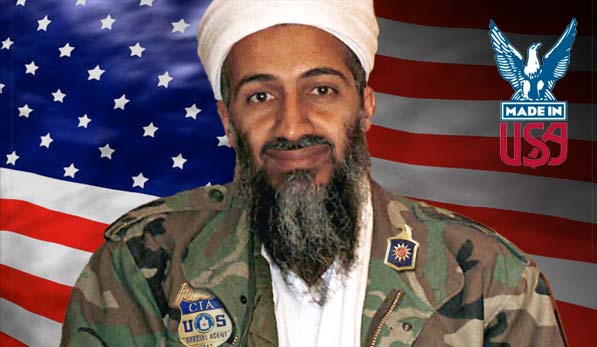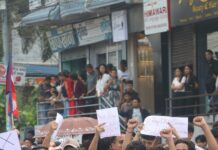Despite their recent propaganda it was US governments that helped to create the Frankenstein’s monster of right-wing islamism and al Qaeda
We here republish a review article from 2004 by Laurence Coates in Socialism Today (journal of the CWI in England and Wales), of two books looking at conservative islamic fundamentalism and the origins of al Qaeda in particular. On May 2, 2011, US elite forces in Pakistan killed the al Qaeda leader Osama bin Laden. This was hailed as a great victory for President Obama’s administration and the US military, but as we explained it will do nothing to bring an early end to the disastrous war in Afghanistan or create stability in Pakistan. According to the United Nations, May 2011 was the worst month on record for civilian casualties in Afghanistan. This article, and the books by John K Cooley and Dilip Hiro, show which role US governments played in creating the Frankenstein’s monster of right-wing islamism, including al Qaeda.
War Without End: the rise of Islamist fundamentalism & the global response
By Dilip Hiro
Routledge, 2002, £19-99
Unholy Wars: Afghanistan, America & international terrorism
By John K Cooley
Penguin, 2002, £17-95
Political Islam is now demonised by Washington as the main threat to the capitalist ‘civilised world’. But these two books show that the US has a long history of sponsoring Islamist reaction and terrorism – in Afghanistan, Saudi Arabia, Pakistan, Indonesia and elsewhere – in pursuit of its own global interests.
In the 1980s, as part of its covert war against the Soviet army in Afghanistan, the CIA printed tens of thousands of copies of the Koran. Less benignly, the US also provided arms and funds for what John K Cooley describes as “a huge foreign mercenary army; one of the largest ever seen in American military history”. In so doing, the US “uncorked the bottle containing the genies which would, in the 1980s and 1990s, unleash terrorist violence and help spread the culture of drugs around the world, from New York to the Philippines”. Washington initiated “a process that would culminate 21 years later in the horrific attacks by suicide bombers directed by the Afghanistan-based Osama bin Laden”, says Dilip Hiro.
The earliest example of a strategic alliance between ‘democratic’ US imperialism and ultra-conservative Islam is that of Saudi Arabia. On the basis of close economic and political ties between their respective elites, US imperialism continues to support the Saudi princes’ brutal dictatorship.
From 1979, after the Soviet occupation of Afghanistan, the US gave the Saudi regime a license to export is own brand of right-wing Sunni Islam, Wahhabism, whose adherents include bin Laden and the Taliban. In return, the Saudi royal family, which portrays itself as the global guardian of the Islamic faith and its holiest shrines, funded pro-US (and patently non-Islamic) terror gangs in Nicaragua, Panama, Angola and Mozambique, and acted as a proxy for US interests in the Arab world.
Saudi Arabia, which Hiro calls “the oldest fundamentalist state”, was founded in 1932 by Abdul Aziz ibn Abdul Rahman al Saud. Its alliance with US imperialism dates back to 1933 when it granted an oil concession to the Standard Oil Company. Wahhabism and Western imperialism, far from being antagonistic entities, reached an historical accommodation based on oil in return for protection.
The Saudi ruling family has been closely linked to the Wahhabi sect, not least through intermarriage with the descendents of the sect’s founder, since the middle of the 18th century. The symbol of the crossed swords on the Saudi flag signifies the union of these two institutions. With Wahhabism as his ideological tool, Abdul Aziz imposed a centralised system of rule on the disparate tribes of the Arabian peninsular in the first decades of the 20th century. This was achieved with the help of a 150,000-strong Islamic militia, the Ikhwan, drawn from nomadic tribes.
With the unification of the Arabian peninsular, however, Abdul Aziz turned against the Ikhwan whose ambition to unify the entire region threatened to destabilise the fledgling state and trigger a conflict with British and French imperialism. In 1927 he signed the Treaty of Jiddah, recognising Britain as the “protector of the Gulf of Oman, Transjordan and Iraq”. Two years later, with military aid from the British, the Saudi leader crushed the Ikhwan forces.
This episode is instructive. To this day, the House of Saud relies on a mix of puritanical Islam and alliances with ‘Christian’ imperialist powers, as in August 1990 when Saddam Hussein invaded Kuwait. The ruling family – more than 4,000 princes – occupies the top military and governmental posts and runs Saudi Arabia’s major companies. “In a sense”, says Hiro, “the inflated royal family paralleled the single ruling party in many secular Third World countries, held together by blood rather than any particular social ideology”.
The Soviet Union’s invasion of Afghanistan, to prop up a pro-Soviet government in late 1979, marked a turning point in the fortunes of ultra-conservative political Islam. “You must understand”, said one guerrilla commander quoted by Cooley, “that the [Afghan resistance’s political parties] were very small then. Our organisation in Kabul was very small”. US funding would change this. And the rise of radical Shia Islam in neighbouring Iran pushed the US into an even closer alliance with Sunni Islamist reaction in Saudi Arabia and Pakistan.
The US and its allies funded, armed and trained between 80,000 and 150,000 Islamist guerrillas, or mujaheddin, hailed as ‘freedom fighters’ by Ronald Reagan, US president from 1981-88. In 2001, when the US sent troops to Afghanistan, these ‘freedom fighters’ were reclassified as ‘illegal combatants’ and denied the basic rights of prisoners under the Geneva Convention. The training manuals used by al-Qa’ida operatives today are based closely on the CIA and Pentagon manuals issued to the mujaheddin in the 1980s. “US Marine training manuals translated into Persian, Arabic and Urdu”, writes Hiro, “were found to be particularly good in teaching the recruits how to make booby traps and break down weapons”.
The aim of US policy in Afghanistan, as first formulated by Zbigniew Brzezinski, national security adviser to president Jimmy Carter (1977-80), was not just to cause the withdrawal of Soviet forces, but to spread a virulent cocktail of reactionary Islam and nationalism into the predominantly Muslim Central Asian republics of the Soviet Union. To this end, Washington – through its Saudi and Pakistani allies – promoted the most extreme Islamist groups within the Afghan opposition. Those who advocated a more cautious line, like secretary of state Cyrus Vance, were overruled. The first covert CIA aid to the mujaheddin was authorised by Carter on 3 July 1979 – six months before the Soviet invasion. Twenty-two years later, Carter was awarded the Nobel peace prize!
Brzezinski subsequently claimed that the aim was to provoke Moscow into invading Afghanistan and thereby ‘give the Soviet Union its own Vietnam war’. Asked by a reporter if he regretted this in the light of subsequent events, Cooley reports Brzezinski as saying, “Which was more important in world history? The Taliban or the fall of the Soviet Empire?”
The US allowed Saudi Arabia to export Wahhabism throughout the Muslim world. Washington acquiesced to the ‘Islamisation’ of Pakistan under dictator Zia ul Haq (1977-88) and his powerful Inter-Services Intelligence (ISI) directorate. Zia, whose role as a conduit for arms and funds to the mujaheddin was vital to imperialism, leant upon right-wing religious leaders to shore up his own fragile position. The growth of the Wahhabi sect – based on huge amounts of Saudi funding to religious schools (madrassahs) and the mujaheddin – led to increased sectarian polarisation and attacks on Pakistan’s Shia Muslim minority (about 20% of the population).
These processes would later lead to the formation of the Taliban in the 1990s which, in Cooley’s words, was “created in the laboratories, so to speak, of Pakistani intelligence, the ISI – in order to produce a counter-force to Iran and Iranian Islamism”.
With Pakistani arms and logistical support, the Taliban was quickly able to fill the post-Soviet vacuum in Afghanistan, capturing the capital, Kabul, in 1996. The Taliban regime banned music, dancing, television and chess. It expelled women from employment and education. These edicts had no basis in Afghanistan’s own, more tolerant and heterogeneous Islamic traditions. Minorities, such as the Hazaris and other Shias, suffered brutal persecution.
The US-led operation in Afghanistan required massive funding. A full-time mujaheddin fighter’s pay could range from $100 to $300 a month – compared to $162 a month for a Pakistani army captain. Cooley notes: “For the majority of Afghans, Pakistanis, Algerians, Egyptians, Filipinos and others, these were huge sums”. Although the US defence department’s secret ‘black budget’ quadrupled to $36 billion a year between 1981-90, Washington faced serious constraints over funding the Afghan war, not least because of the need to maintain ‘deniability’.
As costs spiralled, Washington encouraged the wholesale switch of Afghanistan’s economy towards opium production to provide illicit funds. As a result, writes Cooley, “from slight production before the Russians and CIA began the war in 1979, the so-called Golden Crescent countries of Pakistan and Afghanistan have grown into the largest centre of heroin production, consumed elsewhere as well as locally, in the world”. Today, Afghanistan accounts for 75% of global opium production. The effects in the region have been devastating: “Social workers found around 200,000 child heroin addicts in Pakistan. By January 2000, more than one million addicts, including 80,000 children, lived in Karachi alone”.
The US also turned to the Saudi regime to enlist the support of wealthy individuals as bankers to the Islamist counterrevolution. Cooley calls this “the creeping privatisation of the jihad” for which bin Laden became the foremost symbol. His organisation, al-Qa’ida (the base), was set up in 1985 under the tutelage of Saudi military intelligence, the Istikhabarat. As an unofficial ambassador of the Saudi regime, Hiro recounts how “bin Laden had by now initiated a scheme of recruiting volunteers from the Arab world to join the anti-Soviet jihad, an enterprise in which he had the active backing of the Saudi intelligence chief, Prince Turki. This programme was then extended to the non-Arab Muslim world. By the time the Afghan mujadeddin captured Kabul in 1992, an estimated 35,000 Islamists from 43 countries had participated in the jihad, nearly two-thirds of them from Arab states, with the Saudi kingdom contributing 15,000 – according to Saudi foreign minister, Saud al Faisal – followed by Yemen, Algeria and Egypt”. In this way, the future leaders of Jemaah Islamiyah in Indonesia (responsible for the Bali bombing in October 2002), the Abu Sayyaf group in the Philippines and GIA in Algeria, all received training as guests of the CIA with bin Laden as their tour guide.
Bin Laden had extremely close links to the corrupt House of Saud until 1990-91. On the death of his father, Muhammed bin Laden, in 1968, King Faisal told Osama bin Laden and his brothers, ‘I am going to be your father now’. The family business – the biggest construction conglomerate in the world – was protected by a royal decree and awarded fat contracts from the state, including rebuilding the Grand Mosque in Mecca. When the Khobar Tower, used by US servicemen, was bombed in 1996, it landed the $150 million reconstruction contract. And when US troops moved to a new location, they were met by a huge billboard: ‘Security upgraded by the Saudi Bin Laden Group’. Throughout the 1980s, as Hiro makes clear, bin Laden’s “activities dovetailed with the official Saudi policy”. Al-Qa’ida was set up “on corporate lines”, with four executive committees (military, business, Islamic studies and media).
The turning point came when Saddam’s forces invaded neighbouring Kuwait. The House of Saud, facing serious tremors of opposition at home, was terrified at the possibility of a continued Iraqi offensive into its own territory. This fear was shared in Washington. Bin Laden, back in the Saudi kingdom after a decade in Afghanistan and Pakistan, was opposed to allowing US forces into the country. This reflected a wider split in the Saudi regime and Wahhabi clergy. Crown Prince Abdullah, today the de facto ruler of Saudi Arabia, also opposed inviting the Americans. A leading Wahhabi cleric accused the royal family of placing “its trust in the president of America rather than in God”. In fact, as Hiro points out, there had been a history of US troops on Saudi soil, continuously since 1980, which bin Laden and others would have known. This time, however, the presence of US forces would be public knowledge.
In a meeting with the defence minister, Prince Sultan, Hiro explains how bin Laden outlined his alternative of “complementing the kingdom’s military with 30,000 battle-hardened Afghani Arabs, about half of them Saudi nationals, who had participated in the successful anti-Soviet jihad”. Sultan and his fellow ministers evidently recoiled from this idea in horror – just as 70 years earlier the Ikhwan militias had been reined in because they posed a threat as an independent power base outside the regime’s control. By this time, most of bin Laden’s jihadis were under surveillance by the secret police.
Along with 200 other prominent personalities, bin Laden petitioned King Fahd in a private letter, the contents of which are still secret. When these efforts failed, bin Laden became an open critic of the regime. This led to his movements being restricted, withdrawal of Saudi citizenship, then exile to Sudan in 1994. There he was the target of an assassination attempt (the first of several) by the Saudi state, probably with US collusion. In 1995, King Fahd purged the ranks of the senior Islamic clergy (ulema). However, these measures have not succeeded in restoring stability.
Both books are damning indictments of US policy towards the Muslim world. War Without End, by India-born Dilip Hiro, contains by far the best historical material, but is less interesting on more recent events. Unholy Wars, by veteran US journalist John K Cooley, is the more hard-hitting book, especially on the dirty tricks employed by successive US administrations.





